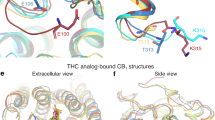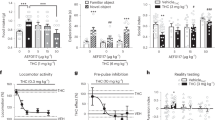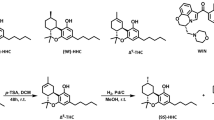Abstract
Repeated administration of Δ9-tetrahydrocannabinol (THC), the primary psychoactive constituent of Cannabis sativa, induces profound tolerance that correlates with desensitization and downregulation of CB1 cannabinoid receptors in the CNS. However, the consequences of repeated administration of the endocannabinoid N-arachidonoyl ethanolamine (anandamide, AEA) on cannabinoid receptor regulation are unclear because of its rapid metabolism by fatty acid amide hydrolase (FAAH). FAAH−/− mice dosed subchronically with equi-active maximally effective doses of AEA or THC displayed greater rightward shifts in THC dose–effect curves for antinociception, catalepsy, and hypothermia than in AEA dose–effect curves. Subchronic THC significantly attenuated agonist-stimulated [35S]GTPγS binding in brain and spinal cord, and reduced [3H]WIN55,212-2 binding in brain. Interestingly, AEA-treated FAAH−/− mice showed less CB1 receptor downregulation and desensitization than THC-treated mice. Experiments examining tolerance and cross-tolerance indicated that the behavioral effects of THC, a low efficacy CB1 receptor agonist, were more sensitive to receptor loss than those of AEA, a higher efficacy agonist, suggesting that the expression of tolerance was more affected by the intrinsic activity of the ligand at testing than during subchronic treatment. In addition, the CB1 receptor antagonist, rimonabant, precipitated a markedly reduced magnitude of withdrawal in FAAH−/− mice treated subchronically with AEA compared with mice treated repeatedly with THC. The findings that repeated AEA administration produces lesser adaptive changes at the CB1 receptor and has reduced dependence liability compared with THC suggest that pharmacotherapies targeting endocannabinoid catabolic enzymes are less likely to promote tolerance and dependence than direct acting CB1 receptor agonists.
Similar content being viewed by others
Log in or create a free account to read this content
Gain free access to this article, as well as selected content from this journal and more on nature.com
or
References
Aceto MD, Scates SM, Razdan RK, Martin BR (1998). Anandamide, an endogenous cannabinoid, has a very low physical dependence potential. J Pharmacol Exp Ther 287: 598–605.
Bohn LM, Dykstra LA, Lefkowitz RJ, Caron MG, Barak LS (2004). Relative opioid efficacy is determined by the complements of the G protein-coupled receptor desensitization machinery. Mol Pharmacol 66: 106–112.
Breivogel CS, Childers SR, Deadwyler SA, Hampson RE, Vogt LJ, Sim-Selley LJ (1999). Chronic delta9-tetrahydrocannabinol treatment produces a time-dependent loss of cannabinoid receptor-activated G-proteins in brain. J Neurochem 73: 2447–2459.
Breivogel CS, Lambert JM, Gerfin S, Huffman JW, Razdan RK (2008). Sensitivity to delta9-tetrahydrocannabinol is selectively enhanced in beta-arrestin2 −/− mice. Behav Pharmacol 19: 298–307.
Breivogel CS, Scates SM, Beletskaya IO, Lowery OB, Aceto MD, Martin BR (2003). The effects of delta9-tetrahydrocannabinol physical dependence on brain cannabinoid receptors. Eur J Pharmacol 459: 139–150.
Breivogel CS, Selley DE, Childers SR (1998). Cannabinoid receptor agonist efficacy for stimulating [35S]GTPγS binding to rat cerebellar membranes correlates with agonist-induced decreases in GDP affinity. J Biol Chem 273: 16865–16873.
Budney AJ, Hughes JR (2006). The cannabis withdrawal syndrome. Curr Opin Psychiatry 19: 233–238.
Colquhoun D (1971). Lectures on biostatistics: an introduction to statistics with applications in biology & medicine. Clarendon Press: Oxford, pp 327–332.
Compton DR, Johnson MR, Melvin LS, Martin BR (1992). Pharmacological profile of a series of bicyclic cannabinoid analogs: classification as cannabimimetic agents. J Pharmacol Exp Ther 260: 201–209.
Cook SA, Lowe JA, Martin BR (1998). CB1 receptor antagonist precipitates withdrawal in mice exposed to Delta9-tetrahydrocannabinol. J Pharmacol Exp Ther 285: 1150–1156.
Cravatt BF, Demarest K, Patricelli MP, Bracey MH, Giang DK, Martin BR et al (2001). Supersensitivity to anandamide and enhanced endogenous cannabinoid signaling in mice lacking fatty acid amide hydrolase. Proc Natl Acad Sci USA 98: 9371–9376.
Fride E (1995). Anandamides: tolerance and cross-tolerance to delta 9-tetrahydrocannabinol. Brain Res 697: 83–90.
Glass M, Dragunow M, Faull RLM (1997). Cannabinoid receptors in the human brain: a detailed anatomical and quantitative autoradiographic study in the fetal, neonatal and adult human brain. Neuroscience 77: 299–318.
Herkenham M, Lynn AB, Johnson MR, Melvin LS, de Costa BR, Rice KC (1991). Characterization and localization of cannabinoid receptors in rat brain: a quantitative in vitro autoradiographic study. J Neurosci 11: 563–583.
Hollister LE (1986). Health aspects of cannabis. Pharmacol Rev 38: 1–20.
Howlett AC, Barth F, Bonner TI, Cabral G, Casellas P, Devane WA et al (2002). International Union of Pharmacology. XXVII. Classification of cannabinoid receptors. Pharmacol Rev 54: 161–202.
Hutcheson DM, Tzavara ET, Smadjs C, Valjent E, Roques BP, Hanoune J et al (1998). Behavioural and biochemical evidence for signs of abstinence in mice chronically treated with Δ9-tetrahydrocannabinol. Br J Pharmacol 125: 1567–1577.
Jayamanne A, Greenwood R, Mitchell VA, Aslan S, Piomelli D, Vaughan CW (2006). Actions of the FAAH inhibitor URB597 in neuropathic and inflammatory chronic pain models. Br J Pharmacol 147: 281–288.
Jones RT, Benowitz N, Bachman J (1976). Clinical studies of cannabis tolerance and dependence. Ann N Y Acad Sci 282: 221–239.
Jones RT, Benowitz NL, Herning RI (1981). Clinical relevance of cannabis tolerance and dependence. J Clin Pharmacol 21: 143S–152S.
Kathuria S, Gaetani S, Fegley D, Valino F, Duranti A, Tontini A et al (2003). Modulation of anxiety through blockade of anandamide hydrolysis. Nat Med 9: 76–81.
Lichtman AH, Leung D, Shelton CC, Saghatelian A, Hardouin C, Boger DL et al (2004a). Reversible inhibitors of fatty acid amide hydrolase that promote analgesia: evidence for an unprecedented combination of potency and selectivity. J Pharmacol Exp Ther 311: 441–448.
Lichtman AH, Martin BR (2002). Marijuana withdrawal syndrome in the animal model. J Clin Pharmacol 42: 20S–27S.
Lichtman AH, Martin BR (2005). Cannabinoid tolerance and dependence. Handb Exp Pharmacol 691–717.
Lichtman AH, Shelton CC, Advani T, Cravatt BF (2004b). Mice lacking fatty acid amide hydrolase exhibit a cannabinoid receptor-mediated phenotypic hypoalgesia. Pain 109: 319–327.
Martin BR, Sim-Selley LJ, Selley DE (2004). Signaling pathways invovled in the development of cannabinoid tolerance. Trends Pharmacol Sci 25: 325–330.
Paronis CA, Holtzman SG (1992). Development of tolerance to the analgesic activity of mu agonists after continuous infusion of morphine, meperidine or fentanyl in rats. J Pharmacol Exp Ther 262: 1–9.
Pertwee RG, Stevenson LA, Griffin G (1993). Cross-tolerance between delta-9-tetrahydrocannabinol and the cannabimimetic agents, CP 55,940, WIN 55,212-2 and anandamide. Br J Pharmacol 110: 1483–1490.
Romero J, Berrendero F, Garcia-Gil L, Lin SY, Makriyannis A, Ramos JA et al (1999). Cannabinoid receptor and WIN-55,212-2-stimulated [35S]GTPgammaS binding and cannabinoid receptor mRNA levels in several brain structures of adult male rats chronically exposed to R-methanandamide. Neurochem Int 34: 473–482.
Romero J, Garcia L, Fernandez-Ruiz JJ, Cebeira M, Ramos JA (1995). Changes in rat brain cannabinoid binding sites after acute or chronic exposure to their endogenous agonist, anandamide, or to delta 9-tetrahydrocannabinol. Pharmacol Biochem Behav 51: 731–737.
Rubino T, Patrini G, Massi P, Fuzio D, Vigano D, Giognoni G et al (1998). Cannabinoid-precipitated withdrawal: a time-course study of the behavioral aspect and its correlation with cannabinoid receptors and G protein expression. J Pharmacol Exp Ther 285: 813–819.
Rubino T, Vigano D, Costa B, Colleoni M, Parolaro D (2000). Loss of cannabinoid-stimulated guanosine 5′-O-(3-[(35)S]thiotriphosphate) binding without receptor down-regulation in brain regions of anandamide-tolerant rats. J Neurochem 75: 2478–2484.
Schlosburg JE, Carlson BL, Ramesh D, Abdullah RA, Long JZ, Cravatt BF et al (2009). Inhibitors of endocannabinoid-metabolizing enzymes reduce precipitated withdrawal responses in THC-dependent mice. AAPS J 11: 342–352.
Selley DE, Cassidy MP, Martin BR, Sim-Selley LJ (2004). Long-term administration of delta9-tetrahydrocannabinol desensitizes CB1-, adenosine A1-, and GABAB-mediated inhibition of adenylyl cyclase in mouse cerebellum. Mol Pharmacol 66: 1275–1284.
Sim-Selley LJ (2003). Regulation of cannabinoid CB1 receptors in the central nervous system by chronic cannabinoids. Crit Rev Neurobiol 15: 91–119.
Sim-Selley LJ, Martin BR (2002). Effect of chronic administration of WIN 55,212-2 or Δ9-tetrahydrocannabinol on cannabinoid receptor adaptation in mice. J Pharmacol Exp Ther 303: 36–44.
Sim-Selley LJ, Schechter NS, Rorrer WK, Dalton GD, Hernandez J, Martin BR et al (2006). Prolonged recovery rate of CB1 receptor adaptation after cessation of long-term cannabinoid administration. Mol Pharmacol 70: 986–996.
Smith PB, Compton DR, Welch SP, Razdan RK, Mechoulam R, Martin BR (1994). The pharmacological activity of anandamide, a putative endogenous cannabinoid, in mice. J Pharmacol Exp Ther 270: 219–227.
Tsou K, Patrick SL, Walker JM (1995). Physical withdrawal in rats tolerant to Δ9-tetrahydrocannabinol precipitated by a cannabinoid receptor antagonist. Eur J Pharmacol 280: R13–R15.
Tzavara ET, Valjent E, Firmo C, Mas M, Beslot F, Defer N et al (2000). Cannabinoid withdrawal is dependent upon PKA activation in the cerebellum. Eur J Neurosci 12: 1038–1046.
Villares J (2007). Chronic use of marijuana decreases cannabinoid receptor binding and mRNA expression in the human brain. Neuroscience 145: 323–334.
Welch SP (1997). Characterization of anandamide-induced tolerance: comparison to delta-9-THC-induced interactions with dynorphinergic systems. Drug Alcohol Depend 45: 39–45.
Wiley JL, Smith FL, Razdan RK, Dewey WL (2005). Task specificity of cross-tolerance between Delta9-tetrahydrocannabinol and anandamide analogs in mice. Eur J Pharmacol 510: 59–68.
Willoughby KA, Moore SF, Martin BR, Ellis EF (1997). The biodisposition and metabolism of anandamide in mice. J Pharmacol Exp Ther 282: 243–247.
Wilson DM, Varvel SA, Harloe JP, Martin BR, Lichtman AH (2006). SR 141716 (rimonabant) precipitates withdrawal in marijuana-dependent mice. Pharmacol Biochem Behav 85: 105–113.
Wise LE, Shelton CC, Cravatt BF, Martin BR, Lichtman AH (2007). Assessment of anandamide's pharmacological effects in mice deficient of both fatty acid amide hydrolase and cannabinoid CB1 receptors. Eur J Pharmacol 557: 44–48.
Acknowledgements
These studies were supported by NIH grants R01DA014277, P01DA017259, R01DA15197, R01DA03672, R01DA02396, R01DA015683, P50DA005274, P01DA009789, T32DA007027, and F31DA026279 and The Institute of International Education/Scholar Rescue Funds/New York (RA).
Author information
Authors and Affiliations
Corresponding author
Ethics declarations
Competing interests
This research has been supported solely by the National Institutes of Health (NIH). The following authors KWF, JES, RAA, THS, DES, and LJS declare that, except for income received from the primary employer, no financial support or compensation has been received from any individual or corporate entity over the past 3 years for research or professional service and there are no personal financial holdings that could be perceived as constituting a potential conflict of interest. AHL, BFC, and AJT report no conflicts of interest with the work presented in this manuscript. AJT was employed by Abbott labs after completion of this work and is currently employed by AMAG Pharmaceuticals. AHL declares that over the past 3 years he has received compensation from Pfizer, Ironwood Pharmaceuticals, and Allergan. In addition, AHL has received funding from Pfizer and Ironwood for contracts unrelated to the research presented in this paper. BFC declares that over the past 3 years, he has received compensation from Pfizer, Activx Biosciences, and aTyr Pharma.
Rights and permissions
About this article
Cite this article
Falenski, K., Thorpe, A., Schlosburg, J. et al. FAAH−/− Mice Display Differential Tolerance, Dependence, and Cannabinoid Receptor Adaptation After Δ9-Tetrahydrocannabinol and Anandamide Administration. Neuropsychopharmacol 35, 1775–1787 (2010). https://doi.org/10.1038/npp.2010.44
Received:
Revised:
Accepted:
Published:
Issue date:
DOI: https://doi.org/10.1038/npp.2010.44
Keywords
This article is cited by
-
Increased 2-arachidonoyl-sn-glycerol levels normalize cortical responses to sound and improve behaviors in Fmr1 KO mice
Journal of Neurodevelopmental Disorders (2021)
-
Evidence for the Endocannabinoid System as a Therapeutic Target in the Treatment of Cannabis Use Disorder
Current Addiction Reports (2020)
-
Cannabis Withdrawal: a Review of Neurobiological Mechanisms and Sex Differences
Current Addiction Reports (2017)
-
Cannabinoid CB2 receptor ligand profiling reveals biased signalling and off-target activity
Nature Communications (2017)
-
Cannabinoid-based drugs targeting CB1 and TRPV1, the sympathetic nervous system, and arthritis
Arthritis Research & Therapy (2015)



